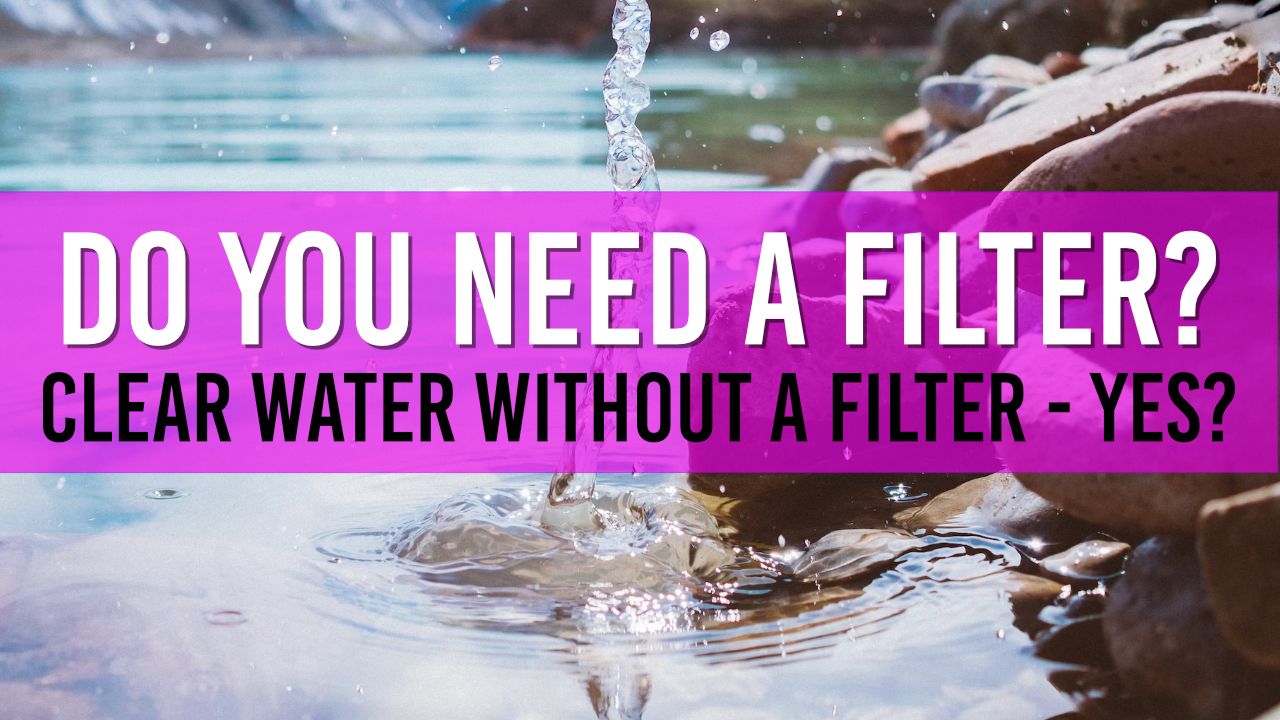Can you keep your Pond Water clear without a filter box?
Yes it's completely possible to keep your pond water clear without a filter. The real question is should you? If you have the time and energy to keep on top of algae, debris and all the things that a filter does - then yes go for it!

Table of Contents
A clear and healthy pond is not only visually appealing but also essential for maintaining a thriving aquatic ecosystem. For my long term readers, you will know that I always say "You need filters if you plan on keeping fish in your pond".
But what if you didn't actually need a dedicated filtration system to maintain a healthy clear pond. In this article I look at alternative ways to keep your pond water clear without using a filter box.
Regular Pond Maintenance
It's no lie that regular pond maintenance will help any pond (filter or no filter). Ponds that are completely neglected will not be as healthy as those where you perform basic maintenance.
Remove leaves and twigs from your pond
Regularly removing debris such as leaves, twigs, and other organic materials is crucial for maintaining clear pond water. Use a pond skimmer or a net to collect and dispose of debris that accumulates on the water surface. This will prevent the formation of a nutrient-rich environment that encourages algae growth.
Keep your Pond Plants under control
Overgrown pond plants can contribute to murky water by trapping debris in between leaves. Trim and maintain plants periodically to promote healthy growth and prevent them from overtaking the pond.
Trimmping / Clipping your pond plants will ensure they are not competing with each other for essential resources.
Proper Fish Stocking
The type & quantity of fish you keep will certainly affect your pond's water quality. Too many fish in your pond and the wrong type of fish will make it very difficult to keep your water quality under control.
Choosing the right fish species
Selecting fish species that do not produce excessive waste is essential for maintaining clear water. I've prepared a table comparing the waste production levels of several common garden pond fish species:
| Fish Species | Waste Production Level | Notes |
|---|---|---|
| Goldfish | Low | Hardy and adaptable, suitable for ponds of various sizes |
| Koi | Low to Moderate | Require ample space and proper care, but are relatively low-waste |
| Shubunkin | Low | A type of goldfish, shares similar waste production characteristics |
| Comet Goldfish | Low | Another goldfish variety with low waste production |
| Orfe (Ide) | Moderate | Fast swimmers, require well-oxygenated water |
| Tench | Moderate | Bottom-dwellers, prefer heavily planted ponds |
| Golden Rudd | Moderate | Omnivorous, well-suited for larger ponds |
| Plecostomus | High | Not ideal for most garden ponds due to high waste production |
Goldfish / Shubunkin / Comets produce the lowest amounts of pond waste.
Avoiding overstocking
Adding too many fish to your pond can lead to poor water quality and clarity. As a general guideline, allow 10 gallons of water per inch of fish to maintain a healthy environment. This will provide ample space for your fish to thrive and prevent excessive waste accumulation.
More fish = More waste
Implementing Natural Filtration Methods
Using plants for filtration
Aquatic plants play a vital role in maintaining water clarity by absorbing excess nutrients, providing a natural barrier against debris, and contributing to a balanced ecosystem.
The following table lists some of the best pond plants for absorbing excess nutrients:
| Plant Type | Plant Name | Benefits & Characteristics |
|---|---|---|
| Floating Plants | Duckweed (Lemna spp.) | Efficient at absorbing excess nutrients, provides shade, and helps control algae growth |
| Floating Plants | Water Hyacinth (Eichhornia crassipes) | Rapid nutrient absorber, can help reduce algae, but may require regular removal due to its invasive nature |
| Submerged Plants | Hornwort (Ceratophyllum demersum) | Oxygenates the water, absorbs nutrients, and provides hiding spots for fish |
| Submerged Plants | Anacharis (Elodea spp.) | Efficient nutrient absorber, oxygenates the water, and provides habitat for aquatic creatures |
| Marginal Plants | Water Iris (Iris spp.) | Absorbs excess nutrients, provides vertical interest, and helps control algae growth |
| Marginal Plants | Pickerel Rush (Pontederia cordata) | Effective at removing excess nutrients and provides habitat for beneficial insects |
| Lily-like Plants | Water Lily (Nymphaea spp.) | Absorbs nutrients, provides shade, and helps control algae growth by reducing sunlight penetration |
| Lily-like Plants | Water Poppy (Hydrocleys nymphoides) | Consumes nutrients, offers shade, and adds aesthetic appeal to the pond |
Duckweed, Water Hyacinth, Hornwort.
Introducing beneficial bacteria
Healthy Pond Bacteria will help break down organic waste, such as fish excrement, dead plant material, and uneaten food, converting them into less harmful substances like carbon dioxide, water, and trace minerals.
By introducing and maintaining a healthy population of beneficial bacteria in your pond, you can improve water clarity and promote overall pond health.
When submerged in water, barley straw releases enzymes and other compounds that promote the growth of beneficial bacteria.
Controlling Algae Growth
Whilst Algae is common in all garden ponds, however excessive growth can lead to murky water and an unbalanced ecosystem. In this section, I will go over some my strategies for controlling algae growth, including limiting sunlight exposure and using algaecides cautiously.
Limiting sunlight exposure
Excess sunlight can encourage algae growth and contribute to murky water. Control sunlight exposure by using shade sails or strategically placing aquatic plants to cast shadows on the pond. This will help prevent excessive algae growth and maintain water clarity.
Using Chemical Treatments to control Algae
In more extreme cases of Algae growth, treatments can be added to your water which cause the algae to die and sink to the bottom of your pond.
Although personally, I tend not to use any chemical treatments, they are a viable option for any pond owner wishing to remove algae fast.
Always read the manufactures guidelines before adding any algae treatments to your pond.
Most Pond Algae treatments will be perfectly safe to use in your garden pond providing your do not exceed the required dosage.
Knowing how much water is in your pond before treatment is key.
Aeration and Circulation
Proper aeration ensures that your pond oxygen levels remain high, promoting the growth of beneficial bacteria and supporting fish health. Good water circulation helps prevent debris build-up, contributes to nutrient distribution, and deters the growth of harmful algae / blanketweed.
The benefits of aeration
Aeration (bubbles) can significantly improve water clarity by breaking the surface tension of the water and allowing oxygen to penetrate your pond water.
Increased oxygen levels in your pond will help promote the growth of beneficial bacteria which is used to break down harmful nitrates in your pond.
Pond Fish absolutely love bubbles, and if you can afford to get a dedicated air pump, I highly recommend a bubble ring. I will often see all my fish swimming through and up the bubbles.
Circulating pond water
Water circulation helps prevent debris build-up and help maintain clear water. You can circulate your pond water by adding small pumps or water features to your pond.
Wildlife / Nature ponds often will have a Solar Powered fountain which helps circulate the pond water whilst adding oxygen.
One of the main reasons your pond smells is because of poor circulation causing your pond water to become stagnant. Adding a small pump to keep water moving around your pond will allow oxygen to enter the water and help release nasty smells.
Conclusion - Can you keep your pond clear without a filter?
In short, yes. You can keep your pond water completely clear without the use of a separate filter. If you have the time, and follow all the above tips, your pond water will be healthy and clear for your fish (and other aquatic life) to exist in harmony.
The real question is... should you?
Pond Filters are designed to help the pond owners enjoy their pond. If you have the time needed to constantly clear out leaves, debris, provide shade on sunny days - then maybe a pond filter is not for you.
If you're like me, who much prefers to enjoy their pond and let the filter boxes do their thing - then get a filter box - it's going to save you so much time & effort in the long run.

